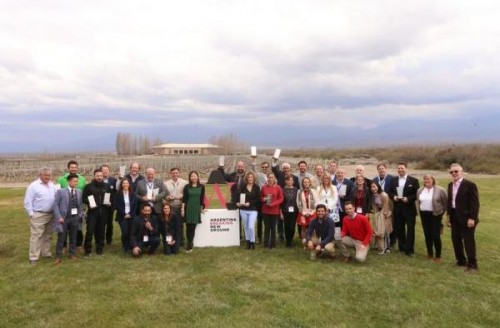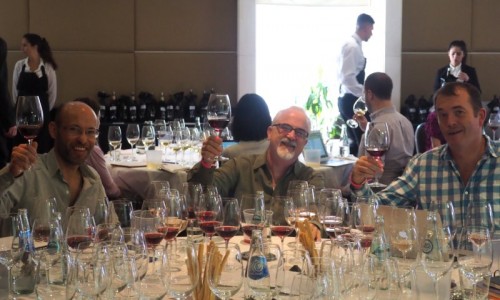
For the last week I have been in Mendoza, Argentina. This is the heart of Argentina’s wine industry, and it is by far the largest region, with 156 000 hectares of vines, which constitutes 75% of the country’s vineyard area. This is a lot: it’s about the same as the area under vine in Australia, and a third again the size of South Africa’s vineyard surface.
I was here to judge the wines of Argentina awards. This year, the judges came from Argentina’s three key markets: the UK, China and the USA. We judged in teams of three, each jury with two internationals and a local judge.

Over all 594 wines were entered, and each wine was judged by two panels. If there was a discrepancy of more than a couple of points between the panels, then the wine was re-tasted by a team of seven to decide which medal it should be awarded. After this, there was a trophy round, where the gold-medal wines were all re-tasted in categories, to pick out the stars. This time, everyone tried all the wines.

Following the judging, we all took part in a seminar for winemakers, held at Salentein’s impressive Killken visitor centre and restaurant in the Uco Valley. Each of us was asked to talk for 10 minutes, covering our own domestic markets, and also talking about wines that we had chosen to show the Argentine winemakers. These were wines that had some success in our local markets, and which we felt had something to say to the locals who were interested in how they can succeed with exports. And then, after a lunch, there was the awards ceremony, where the results were revealed and trophies were handed out.
In total there were 12 international judges, four each from China and the UK, three from the USA, and Paz Levinson, who’s an Argentine sommelier based in Paris. [We are all listed here.] After spending a week together, we really gelled. It felt like a family. It often works this way: put wine people together and they will find common ground, and despite the differences in our backgrounds, ages and personality types, we really forged some nice connections. Everyone joined in and made an effort to get to know their fellow judges, and we even had a lovely late night drinking Fernet Branca and swapping road stories.
What about the judging process itself? The challenge here was dealing with stylistic preferences, and also for many, this was the first time they’d judged a lot of wines like this in blind conditions. Judging wine blind isn’t the easiest thing to do, and the temptation is to reward the outliers in any flight. Often, this means that ripe, sweet wines with lots of concentration do well. If you have judged quite a bit, you are less likely to fall for the big wines, and search for elegance and beauty instead. But there’s also the danger of rewarding wines for what they are not. A wine can’t get a high score just because it isn’t big and ripe. It has to have positive attributes of its own.
The problem comes when people have different notions of what constitutes quality in a wine. There are certainly cultural differences here. Some people have grown up in a culture that celebrates ripeness and concentration, and that doesn’t mind lavish use of new oak. It’s very difficult to come to a consensus if you have different notions of quality.
But it is possible to separate out preference and judgements of quality. Experienced judges are able to assess quality separately from liking, recognizing good examples of varieties or styles that they don’t care for. This is the real challenge of judging consistently and fairly. Being a judge doesn’t give you a chance to punish wine styles that you personally dislike.
I’m going to be publishing my notes and scores on the wines that I tasted over the next few days. It’s always interesting to compare these with scores, given blind, with the scores I give sighted. Most of the time I’m reassured that producers who make wines I like get good scores from me when I taste the wines blind. It’s a nice calibration exercise.
The results are here.
What are my views on Argentine wines after this tasting? There’s lots of reason for excitement, but there are still a few concerns. I really like the inexpensive wines, which generally show direct, pure fruit and give a lot of pleasure, with freshness. Malbec is very strong, Cabernet Franc is strong, Cabernet Sauvignon is struggling a bit. Blends of Malbec and Cabernet Franc are exciting. Bonarda is massively underrated and can yield delicious wines even in the warmer regions, such as east Mendoza. The Uco Valley produces some wonderful wines, while Patagonia shows a lot of potential. And the north also has the potential to make excellent high altitude reds. Whites haven’t really grabbed me yet, although I have tasted a few very good Chardonnays and some stunning Semillon (though not in this competition). I struggle to get excited by Torrents. The concerns? Still too much winemaking at the top end: picking late, making dense, sweetly fruited wines that are then given too much new oak. That’s not the future for Argentina. I also had a few nice sparkling wines here, which showed a lot of promise. I’ll be keeping tabs on Argentine wine over the next few years because it’s at an interesting phase.
3 Comments on Judging the Wines of Argentina Awards 2017
Interest for sure but why so many judges from China?
I agree about the whites. Though certainly dense, overripe, overly oaked wines are not Argentina’s future, neither are the thin, overly acidic, underripe, oakless watery ghosts being promoted by many “new wave” experts, winemakers and sommeliers.
they chose four judges each from their three biggest export markets